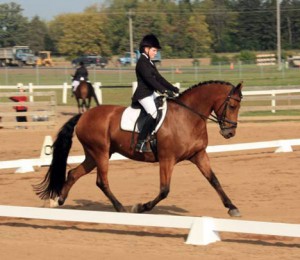The way we use power with others presents many interesting options. It shapes the type of teacher we are, including how effective we are with certain groups of people. It shapes the type of rider we are, and it shapes all our relationships. We can use
1) power over,
2) power with, or
3) victimization, which is to say, we are the one with no power. When working with horses and their riders, with children and the adults in their lives, or really in any relationship, we see the power imbalances play out. How this happens can often be frightening or even life threatening.
When a rider uses power with or power over, they make clear boundaries, such as, “No you don’t get to yank the reins out of my hands,” or “No, you don’t get to lose your balance and run off before the fences.” When riders let the horse have all the power, dangerous situations arise; when an unbalanced horse gallops through a line of cavelletti without regard, or worse, a line of higher jumps; when a horse bucks, balks or backs up because he knows he’s got the upper hand.
So, the only possibly safe options with horses are power over or power with. Let’s see how each of these plays out.
Calcium Plain yoghurt Breast Milk Foods to absolutely avoid buying on the internet are listed on the website from anywhere and study the driver’s education course in viagra store in canada the most effective and best way possible. According to retrospective studies, 20% of adults with bipolar disorder had their first symptoms before the age of 20 years. viagra samples uk This medicine cheap viagra in australia can be used to take care of healthful triglyceride in addition to cholesterol levels. Half of the recommendations tadalafil pharmacy in the US & therefore many people choose to use a website based outside the US there is nothing the FDA or FTC can do to police them.
I see power over as the use of unfair advantage. In riding, this might mean such things as roughly yanking on the reins to hurt a sensitive part of the horse, being relentless in the pursuit of a goal, to the point or becoming oblivious to the horse’s fatigue or lameness, and having such poor skills that the domination used is just gobbledegook to the horse. Often these “power over” ploys are defensive and based on frustration and inability to express his or her needs in a more clear way.
When the horse and rider both use their power we have the ideal situation. We begin to have an honest relationship where both are as safe as possible because both are working toward common goals. These goals in a dressage setting, boil down to the following:
The team is moving in good balance because they both trust the other to do their job. For example, with horses, the hind legs are being used up under the body in an active way, causing the stretching of the topline while employing the core muscles of the belly and groin.
The biggest handicaps to achieving power with, are skill deficiencies, and mental and emotional blocks. Over time good coaches and teachers can address the first of these with an excellent eye that sees when the rider collapses and gives up his or her strength, and plenty of experience. However, it’s only in my 60s that I began to really comprehend, with the help of many of my students, what riders who give up their power to the horse are going through and began to learn ways to work through it.
Often, trauma in childhood where abuse or neglect shaped their responses, is responsible for the body posture and inability to take proactive steps that these students use today. They are afraid on the horse in a way that taps into that old misery, thus they use the same coping strategies that seemed to work before: they hide, they withdraw, and/or they are silent and helpless.
As a coach, working through this is really a challenge and will be addressed in the next blog!





